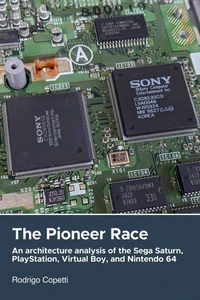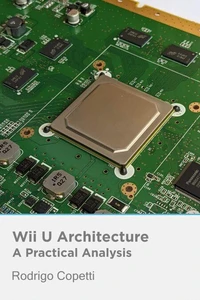PSP Architecture. Architecture of Consoles: A Practical Analysis, #18
Par :Formats :
Disponible dans votre compte client Decitre ou Furet du Nord dès validation de votre commande. Le format ePub est :
- Compatible avec une lecture sur My Vivlio (smartphone, tablette, ordinateur)
- Compatible avec une lecture sur liseuses Vivlio
- Pour les liseuses autres que Vivlio, vous devez utiliser le logiciel Adobe Digital Edition. Non compatible avec la lecture sur les liseuses Kindle, Remarkable et Sony
 , qui est-ce ?
, qui est-ce ?Notre partenaire de plateforme de lecture numérique où vous retrouverez l'ensemble de vos ebooks gratuitement
Pour en savoir plus sur nos ebooks, consultez notre aide en ligne ici
- FormatePub
- ISBN8201876241
- EAN9798201876241
- Date de parution21/04/2021
- Protection num.pas de protection
- Infos supplémentairesepub
- ÉditeurJL
Résumé
Released just one month after the Nintendo DS, Sony's PlayStation Portable (PSP) proved that 'horizontal innovation' is not the only way to succeed in the portable console market. This article is dedicated to anyone that wants to understand, straight to the point, how the PSP operates. It's not a short write-up, but I hope that at the end of the article you will be able to grasp the building blocks of this console (its design rationale, choice of CPUs, GPU pipeline, security system and so forth). Architecture of Consoles: A Practical Analysis Looking at the evolution of video game consoles is fascinating.
While conventional PCs tend to evolve 'incrementally', new generations of consoles introduce completely new ways of working. What you see here is a series of articles that will hopefully uncover the rationale behind the latest trends in technology. They will also demonstrate why each system can't be summarised by its 'bits', megahertz, amount of RAM and whatnot. This is not a developer manual, just an in depth introduction to how each system worked internally.
Bear in mind that tech has gotten really complicated lately, so if you struggle to follow my latest articles, try reading the early ones first. They introduce many concepts and definitions that are constantly revisited. Basic knowledge of computing is preferable, however, I try really hard to adapt my content for wider audiences, so please don't be afraid to give it a try! About this edition This edition originates from the article initially published on my personal website, it's been re-styled to take advantage of the capabilities of eBook documents. While identical content-wise, interactive widgets have been simplified to work with a static environment - in other words, anything that physical pages allow us :), though these will offer a link to the original article in case the reader wants to try the 'full version'.
Please keep this in mind when you see references to interactivity throughout the writings.
While conventional PCs tend to evolve 'incrementally', new generations of consoles introduce completely new ways of working. What you see here is a series of articles that will hopefully uncover the rationale behind the latest trends in technology. They will also demonstrate why each system can't be summarised by its 'bits', megahertz, amount of RAM and whatnot. This is not a developer manual, just an in depth introduction to how each system worked internally.
Bear in mind that tech has gotten really complicated lately, so if you struggle to follow my latest articles, try reading the early ones first. They introduce many concepts and definitions that are constantly revisited. Basic knowledge of computing is preferable, however, I try really hard to adapt my content for wider audiences, so please don't be afraid to give it a try! About this edition This edition originates from the article initially published on my personal website, it's been re-styled to take advantage of the capabilities of eBook documents. While identical content-wise, interactive widgets have been simplified to work with a static environment - in other words, anything that physical pages allow us :), though these will offer a link to the original article in case the reader wants to try the 'full version'.
Please keep this in mind when you see references to interactivity throughout the writings.
Released just one month after the Nintendo DS, Sony's PlayStation Portable (PSP) proved that 'horizontal innovation' is not the only way to succeed in the portable console market. This article is dedicated to anyone that wants to understand, straight to the point, how the PSP operates. It's not a short write-up, but I hope that at the end of the article you will be able to grasp the building blocks of this console (its design rationale, choice of CPUs, GPU pipeline, security system and so forth). Architecture of Consoles: A Practical Analysis Looking at the evolution of video game consoles is fascinating.
While conventional PCs tend to evolve 'incrementally', new generations of consoles introduce completely new ways of working. What you see here is a series of articles that will hopefully uncover the rationale behind the latest trends in technology. They will also demonstrate why each system can't be summarised by its 'bits', megahertz, amount of RAM and whatnot. This is not a developer manual, just an in depth introduction to how each system worked internally.
Bear in mind that tech has gotten really complicated lately, so if you struggle to follow my latest articles, try reading the early ones first. They introduce many concepts and definitions that are constantly revisited. Basic knowledge of computing is preferable, however, I try really hard to adapt my content for wider audiences, so please don't be afraid to give it a try! About this edition This edition originates from the article initially published on my personal website, it's been re-styled to take advantage of the capabilities of eBook documents. While identical content-wise, interactive widgets have been simplified to work with a static environment - in other words, anything that physical pages allow us :), though these will offer a link to the original article in case the reader wants to try the 'full version'.
Please keep this in mind when you see references to interactivity throughout the writings.
While conventional PCs tend to evolve 'incrementally', new generations of consoles introduce completely new ways of working. What you see here is a series of articles that will hopefully uncover the rationale behind the latest trends in technology. They will also demonstrate why each system can't be summarised by its 'bits', megahertz, amount of RAM and whatnot. This is not a developer manual, just an in depth introduction to how each system worked internally.
Bear in mind that tech has gotten really complicated lately, so if you struggle to follow my latest articles, try reading the early ones first. They introduce many concepts and definitions that are constantly revisited. Basic knowledge of computing is preferable, however, I try really hard to adapt my content for wider audiences, so please don't be afraid to give it a try! About this edition This edition originates from the article initially published on my personal website, it's been re-styled to take advantage of the capabilities of eBook documents. While identical content-wise, interactive widgets have been simplified to work with a static environment - in other words, anything that physical pages allow us :), though these will offer a link to the original article in case the reader wants to try the 'full version'.
Please keep this in mind when you see references to interactivity throughout the writings.















